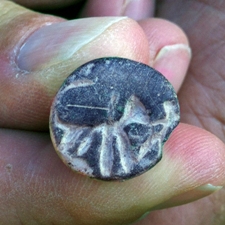Biblical Samson Tale May Be Depicted on Ancient Seal

An ancient seal slightly smaller than a penny apparently depicts a man fighting a lion, which archaeologists believe could be an early reference to the Biblical tale of Samson.
The find doesn't prove that the legendary strongman, who was said to have torn apart a lion as if it were a "young goat," actually lived, but it does "anchor the story in an archaeological setting," said Tel Aviv University archaeologist Shlomo Bunimovitz.
The seal was found at Beth Shemesh, an archaeological site between the ancient cities of Zorah and Eshtaol, about 12 miles (20 kilometers) west of Jerusalem. Archaeologists date the seal to the 12th century B.C.
"If we are right and what we see on the seal is a representation of a man meeting a lion, it shows that the Samson legend already existed around the area of Beth Shemesh during that time period," Bunimovitz said in a statement. "We can date it quite precisely."
Samson's tale, told in the Book of Judges, is one of cross-border communication and conflict. According to legend, Samson was of the Dan tribe of Israelites, born near where the Israelite, Philistine and Canaanite borders met. Samson seeks a wife among the Philistine people and is on his way to secure the marriage he meets the lion and kills it with his bare hands. The marriage engagement goes sour due to a feud between Samson and the bride-to-be's relatives, and ends with Samson slaughtering multiple Philistines and setting fire to their crops using torches tied to the tails of foxes. That story has been depicted in a mosaic dating back to A.D. 400 or 500.
These stories represent the anxiety people felt about the fuzzy borders between their civilizations, according to Zvi Lederman, who co-directs the Beth Shemesh excavations with Bunimovitz.
"When you cross the border, you have to fight the enemy and you encounter dangerous animals. You meet bad things," Lederman said in a statement. "These are stories of contact and conflict, of a border that is more cultural than political."
Get the world’s most fascinating discoveries delivered straight to your inbox.
Follow Stephanie Pappas on Twitter @sipappas or LiveScience @livescience. We're also on Facebook & Google+.

Stephanie Pappas is a contributing writer for Live Science, covering topics ranging from geoscience to archaeology to the human brain and behavior. She was previously a senior writer for Live Science but is now a freelancer based in Denver, Colorado, and regularly contributes to Scientific American and The Monitor, the monthly magazine of the American Psychological Association. Stephanie received a bachelor's degree in psychology from the University of South Carolina and a graduate certificate in science communication from the University of California, Santa Cruz.



